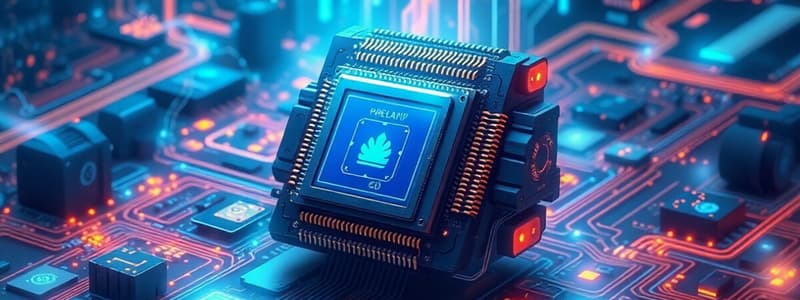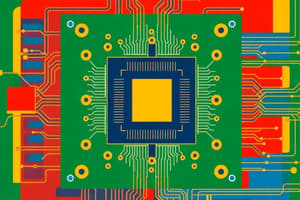Podcast
Questions and Answers
Which of the following factors influences execution time?
Which of the following factors influences execution time?
- Memory capacity
- Arithmetical operations (correct)
- Input/output interfaces
- All of the above
The execution time of multiplying is faster than that of adding.
The execution time of multiplying is faster than that of adding.
False (B)
What is the formula for calculating average execution time?
What is the formula for calculating average execution time?
Σ tinstruction(i)*pinstruction(i)
In dependable systems, the execution time for instructions is __________.
In dependable systems, the execution time for instructions is __________.
Match the performance features with their descriptions:
Match the performance features with their descriptions:
Which performance feature is concerned with the predictability and reliability of a system?
Which performance feature is concerned with the predictability and reliability of a system?
Virtual memory is a type of memory that physically exists outside the computer.
Virtual memory is a type of memory that physically exists outside the computer.
Name one performance feature that relates to the shape of a system.
Name one performance feature that relates to the shape of a system.
The __________ indicates the total cost of a system including operational and purchase costs.
The __________ indicates the total cost of a system including operational and purchase costs.
Which type of memory acts as a high-speed storage area for frequently accessed data?
Which type of memory acts as a high-speed storage area for frequently accessed data?
Which of the following architectures focuses on improving instruction execution efficiency by using multiple instruction pipelines?
Which of the following architectures focuses on improving instruction execution efficiency by using multiple instruction pipelines?
RISC architectures use complex instruction sets to optimize computer performance.
RISC architectures use complex instruction sets to optimize computer performance.
Name one type of memory design studied in advanced computer architectures.
Name one type of memory design studied in advanced computer architectures.
The computer component responsible for executing arithmetic and logic operations is called the _____.
The computer component responsible for executing arithmetic and logic operations is called the _____.
Match the following components with their functionalities:
Match the following components with their functionalities:
Which of the following is NOT a factor that influences the performance of computer systems?
Which of the following is NOT a factor that influences the performance of computer systems?
Parallel architectures utilize a single core for processing tasks.
Parallel architectures utilize a single core for processing tasks.
What is the main focus of the course on advanced computer architectures?
What is the main focus of the course on advanced computer architectures?
One of the design strategies that aims to improve CPU performance is called _____ architectures.
One of the design strategies that aims to improve CPU performance is called _____ architectures.
Which type of memory is best suited for applications requiring high-speed access?
Which type of memory is best suited for applications requiring high-speed access?
Flashcards
Factors influencing computer system performance
Factors influencing computer system performance
The performance of a computer system is influenced by various design decisions and technological advancements.
ALU design
ALU design
The Arithmetic Logic Unit (ALU) is responsible for performing mathematical and logical operations within the CPU.
Pipeline architectures
Pipeline architectures
Instruction pipelining allows multiple instructions to be processed simultaneously, improving the speed of execution.
Super-pipeline architectures
Super-pipeline architectures
Signup and view all the flashcards
Parallel architectures: Multi-core, Multiprocessor
Parallel architectures: Multi-core, Multiprocessor
Signup and view all the flashcards
RISC architecture
RISC architecture
Signup and view all the flashcards
Microprocessors
Microprocessors
Signup and view all the flashcards
Interconnection systems
Interconnection systems
Signup and view all the flashcards
Memory design
Memory design
Signup and view all the flashcards
Memory types: ROM, SRAM, DRAM, SDRAM
Memory types: ROM, SRAM, DRAM, SDRAM
Signup and view all the flashcards
Cache memory
Cache memory
Signup and view all the flashcards
Virtual memory
Virtual memory
Signup and view all the flashcards
Execution time
Execution time
Signup and view all the flashcards
Execution time of operations
Execution time of operations
Signup and view all the flashcards
Reaction time to external events
Reaction time to external events
Signup and view all the flashcards
Memory capacity
Memory capacity
Signup and view all the flashcards
Memory speed
Memory speed
Signup and view all the flashcards
Input/output facilities (interfaces)
Input/output facilities (interfaces)
Signup and view all the flashcards
Development facilities
Development facilities
Signup and view all the flashcards
Dimension and shape
Dimension and shape
Signup and view all the flashcards
Study Notes
Course Information
- Course Title: Structure of Computer Systems (Advanced Computer Architectures)
- Instructor: Gheorghe Sebestyen
- Lab Assistants: Anca Hangan, Madalin Neagu, Ioana Dobos
Course Objectives and Content
- Design of computer components and systems
- Study of methods for increasing computer system speed and efficiency
- Study of advanced computer architectures
Course Content
- Factors influencing computer system performance (e.g., technological trends)
- Computer arithmetic (ALU design)
- CPU design strategies (e.g., pipeline architectures, super-pipelines, parallel architectures, RISC architectures, microprocessors)
- Interconnection systems
- Memory design (ROM, SRAM, DRAM, SDRAM, cache memory, virtual memory)
- Technological trends
Performance Features
- Execution time (execution time of operations, arithmetical operations, simple and complex instructions)
- Reaction time to external events (best effort, interactive systems, real-time systems, worst case execution time (WCET))
- Memory capacity and speed (cache memory, internal memory, external memory)
- Input/output facilities (interfaces)
- Development facilities
- Dimension and shape
- Predictability, safety and fault tolerance
- Costs (absolute and relative)
Physical Performance Parameters
- Clock signal's frequency (a good measure of performance, depends on the integration technology, transistor dimension, path lengths, supply voltage, relative distance between high and low states, clock period, complex CPUs)
- Execution time of a program (more realistic, comparative analysis, benchmarks)
- Other metrics (number of transactions per second, communication bandwidth, context switch time)
Principles for Performance Improvement
- Moore's Law (doubling of transistors every two years)
- Amdahl's Law (speedup limited by the fraction of the program that can't be parallelized)
- Locality principles (time locality, space locality)
- Parallel execution principle (data level, instruction level, thread level, application level)
Improving CPU Performance
- Execution time (Instr_no / IPS)
- CPI (cycles per instruction)
- Methods to reduce execution time (reduce frequency of instructions, reduce CPI, reduce clock signal period, increase frequency)
- Reduce instruction count (improve algorithms, more powerful instructions using multiple operations)
- Reduce CPI (pipeline execution methods, simplify CPU architecture)
- Reduce clock period (reduce dimensions of switches)
Conclusions
- Ways of increasing processor speed (less instructions, simpler instructions, smaller CPI, parallel execution at different levels, higher clock frequency).
Studying That Suits You
Use AI to generate personalized quizzes and flashcards to suit your learning preferences.




